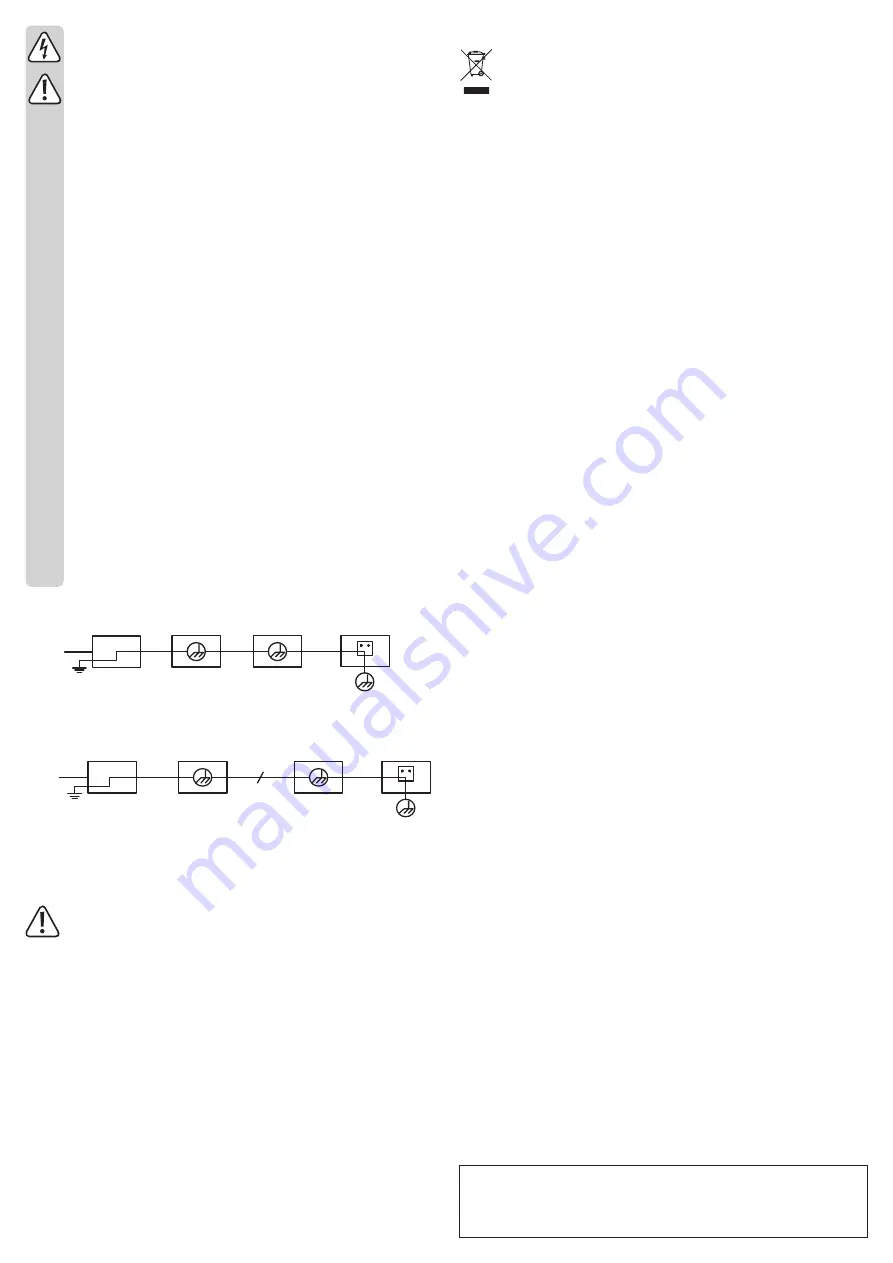
• Avoid exposed electric circuits. Do not touch any exposed connections or compo-
nents when the instrument is supplied with power.
• Do not use the product in the immediate vicinity of strong magnetic or electroma-
gnetic fields, transmitter aerials or HF generators. These may distort the measu
-
rements.
•
Only use measurement cables and accessories that match the specifications of
the oscilloscope.
• Only use insulated measurement probes and measurement leads.
• Before use, inspect the accessory and replace it if it is damaged.
• Remove measurement probes, measurement leads and other accessories imme-
diately after use.
• Remove the USB cable that connects the oscilloscope and the computer.
• Do not apply input voltages higher than the nominal values of the instrument, as
the voltage is transmitted directly to the oscilloscope. Be especially careful when
the probe is set to 1:1 (undamped).
• Do not use exposed metal BNC or banana plugs.
• Do not insert any metal objects into the connections.
• For installations in industrial facilities, follow the accident prevention regulations
for electrical systems and equipment issued by the national safety organisation or
the corresponding national authority.
• In schools, educational facilities, hobby and DIY workshops, measuring devices
must be operated under the responsible supervision of qualified personnel.
• Regularly check the device and test leads for signs of damage.
• Never operate the device when it is open or when any covers are removed!
• FATAL HAZARD! Never exceed the maximum permitted input values. Do not
touch circuits or parts of circuits if they contain voltages higher than 30 V/AC rms
or 30 V/DC (42 V peak), or circuits in which more than 4800 VA may be present!
Fatal hazard! Touching electrical conductors with these voltages may cause a
fatal electric shock.
• The oscilloscope channels are not electrically isolated. All channels have a com-
mon ground during measurements. To prevent short circuits, the grounds must not
be connected to 2 different non-insulated voltage levels.
• Do not measure an AC signal when the oscilloscope is powered by AC (I) or when
the oscilloscope is connected to an AC-powered computer while on battery power
(II).
(I)
Signal
Erde
Prüfspitzen Oszilloskop
Netzteil
Steckdose
Probes
Signal
Earth
Oscilloscope
Power adapter
Socket
(II)
USB/LAN
cable
Probes
Signal
Earth
Oscilloscope
(battery operated)
PC
Socket
Care and cleaning
• Before cleaning the product, switch it off and disconnect it from the mains cable, USB cable
and the measured object.
Opening covers on the product or removing parts that cannot be removed by hand
may expose voltage-carrying components. Before cleaning or repairing the device,
turn it off and disconnect all cables.
• Never use aggressive detergents, rubbing alcohol or other chemical solutions, as these
could damage the housing or even impair the functioning of the product.
• Use a dry, lint-free cloth to clean the product and the measurement cables.
Disposal
Electronic devices are recyclable waste and must not be placed in household waste.
At the end of its service life, dispose of the product according to the relevant statuto-
ry regulations.
You thus fulfil your statutory obligations and contribute to environmental protection.
Technical data
Power ........................................... 100 – 240 V/AC / 50 – 60 Hz
Rechargeable battery ................... LiPo
Operating conditions ..................... 0 to +40 °C, <90 % relative humidity (non-condensing)
Storage conditions ........................ -20 to +60 °C, <90 % relative humidity (non-condensing)
Dimensions (L x W x H) ................ Approx. 270 x 48 x 191 mm
Weight .......................................... Approx. 1700 g
This is a publication by Conrad Electronic SE, Klaus-Conrad-Str. 1, D-92240 Hirschau (www.conrad.com).
All rights including translation reserved. Reproduction by any method, e.g. photocopy, microfilming or capture in electronic
data processing systems, requires the prior written approval of the publisher. Reprinting, also in part, is prohibited. This
publication reflects the technical status at the time of printing.
Copyright 2020 by Conrad Electronic SE.
*2266525_2267610_v1_0920_02_DS_ss_4L_(1)








